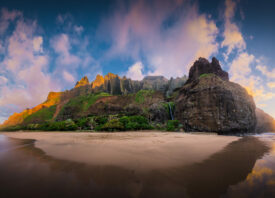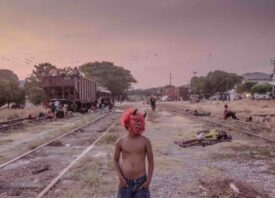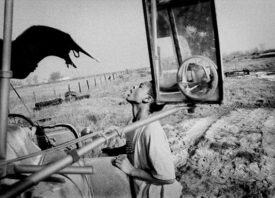Search this site
A Photographer’s Warning About Black Carbon in the Himalayas


Ashley Crowther spent four years documenting the consequences of climate change and black carbon in the Indian Himalayas. That epic journey started in Kumik, a village in Zanskar Valley, where residents have long depended on the water that runs from a nearby mountain glacier. Today, that glacier has retreated, and the once-abundant snowfall has dried up, leaving the people of Kumik without water.
It’s hard (if not impossible) to say to what extent black carbon has contributed to the problem, but along with climate change, these two factors have converged to create a devastating drought.
The photographer was welcomed to Kumik by Tashi Stobdan, a schoolteacher, and his wife Zangmo. He spent the summer with local families, drinking arak (barley wine), chatting about their lives, and learning about the immense strain brought on by a decreasing supply of water.
Over the course of the following years, Crowther, along with the journalist and fixer Ravi Mishra, traced the story of black carbon across the mountains. After Kumik, he went to Jharia, a rural town reshaped by coal mines and burning fires. The whole area is on fire. They traveled by train, stopping and turning back to tell stories from local communities they spotted along the way.
These trips have culminated in the book Our Dark Materials: Black Carbon & the Himalayas, bringing together Crowther’s photographs and in-depth journalism.
Black carbon, sometimes called “soot,” is released into the air when we burn biofuels, fossil fuels, and biomass. From there, it makes its way deep into the lungs, where it can lead to illness and death. In the Himalayas, black carbon comes partially from stoves used for cooking and heating in people’s homes. For that reason, it has a disproportionate effect on women, children, and elderly people.
Beyond its effects on our bodies, black carbon is also a leading contributor to climate change (along with CO2), adding to a complex web of environmental and health concerns throughout the Indian Himalayas. “While climate change has overall warming impacts across the Himalayas, black carbon is now becoming more well-known in the way it exacerbates climate change’s warming impacts,” Crowther explains.
Crowther returned to Kumik in 2019, braving temperatures that plunged to -30 degrees Celsius. This time, he traveled with a friend and colleague, Tanzin Rigzin. “I’ll never forget the last time I visited in the dead of winter with Tanzin after walking along the frozen Zanskar river for seven days, freezing our asses off and sleeping in caves along the river bank,” he tells me.
“We were walking up the hill towards the village, the sun was almost behind a mountain across the valley, and the last flickers of winter light were bouncing off the fresh snow-covered landscape, and we saw the village appear with houses dotting the hillside.” At long last, they’d made it back.
Zangmo Stobdan remembered Crowther immediately and served tea after they’d finished the arduous trip to Kumik. “The best part of that day was the surprise in Zangmo’s voice and facial expression after seeing us in her winter kitchen after a long hiatus,” Crowther remembers. “It was one of genuine care and hospitality. This memory, in particular, will always stick out from a multitude of extraordinary moments.”
The environmental and health risks brought on by black carbon were never too far out of mind, even during the joyful moments. During that winter visit, Crowther also heard about a woman who had died due to breathing problems—likely a lung condition exacerbated by smoke exposure. The suffering people are currently facing in Kumik will expand downstream if the problem is not addressed.
But throughout his journey, Crowther also discovered reasons for hope: black carbon is a problem that can be solved. One potential solution could lie in the use of Liquified Petroleum Gas (LPG), but as of right now, LPG is expensive and therefore remains out of reach for many communities and families. Free LPG connections, provided by governments, could pave the way for a safer future.
Citizens are also creating their own solutions on a local level. Along the way, Tanzin Rigzin introduced the photographer to a “rocket stove,” which he helped to invent. It’s an affordable stove that produces a smokeless flame. “Rocket stoves were a big hit in Zanskar, and more people are using them,” Crowther says. “I got a handful up there myself and installed them in my friend Tashi and Urgain’s homes in 2021. Elsewhere in the Himalayas, more are rolling out.”
Going forward, the photographer sees inventions like this one working hand-in-hand with larger-scale initiatives to tackle black carbon. One of the first steps, he says, is lifting people out of poverty so that they can afford cleaner fuels in the long term. “So much more emphasis must be placed on access to cleaner fuels, especially in rural and poorer areas of the country, as indoor air pollution and outdoor pollution continue to affect hundreds of millions yearly,” he explains.
The photographer remains in touch with Tashi in Kumik and his friend Urgain in Padum, both of whom were instrumental in the creation of this work. “They mentioned to me this year that there wasn’t much snow again, which means less water in the summer growing seasons,” Crowther says. “Unfortunately, water issues are in many ways typical now, so people are prepared for it, but this doesn’t mean it gets easier.”
The people who live in Kumik have seen the book. Crowther tried to bring copies himself last summer, but it was not possible at the time to cross the mountain passes, so he left them with Tanzin Rigzin, who brought them to the village. He hopes to return very soon to see his friends in person.
“The last time I was in Kumik during the winter of 2020, the villagers mentioned that they hoped their plight could raise awareness of water issues across the whole of the Himalayas,” he reflects. “I can only hope that my contribution to the problem has brought some new eyes and ears to the genuine concerns happening to people who have contributed the least to glacier retreat and climate change.”








All images © Ashley Crowther
Further reading:
• In Senegal, a City on the Frontlines of the Climate Crisis
• Picturing the Horrors of Climate Change in Southern Iran



